Home Army
| The Home Army | |
|---|---|
| Armia Krajowa | |
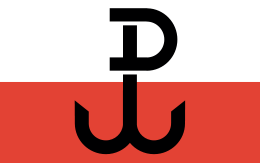 Polish red-and-white flag with superposed Kotwica ("Anchor") emblem of the Polish Underground State and Home Army | |
| Active | 14 February 1942 – 19 January 1945 |
| Country | Poland |
| Allegiance |
|
| Role | Armed forces of the Polish Underground State and the Polish Government-in-Exile |
| Size | 400,000 (1944) |
| Engagements | |
| Commanders | |
| Notable commanders |
Tadeusz Komorowski Stefan Rowecki Leopold Okulicki Emil August Fieldorf Antoni Chruściel |
| Insignia | |
| Identification symbol | Kotwica |
| Part of a series on the |
Underground State |
|---|
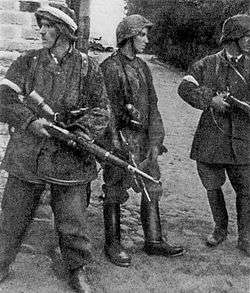 |
|
Authorities |
|
Political organizations |
|
Military organizations |
|
Related topics |
The Home Army (Polish: Armia Krajowa; Polish pronunciation: [ˈarmʲa kraˈjɔva], abbreviated AK) was the dominant Polish resistance movement in Poland, occupied by Nazi Germany and the Soviet Union, during World War II. The Home Army was formed in February 1942 from the Związek Walki Zbrojnej (Armed Resistance). Some authors stress the continuity using acronym ZWZ/AK (or ZWZ-AK).[1] Over the next two years, it absorbed most other Polish underground forces. Its allegiance was to the Polish Government-in-Exile, and it constituted the armed wing of what became known as the "Polish Underground State".
Estimates of the Home Army's 1944 strength range between 200,000 and 600,000, the most commonly cited number being 400,000. This last number would make the Home Army not only the largest Polish underground resistance movement but one of the three largest in Europe during World War II.[a] The Home Army was disbanded on 19 January 1945, after the Soviet Red Army had largely cleared Polish territory of German forces.
The Home Army sabotaged German operations such as transports headed for the Eastern Front in the Soviet Union. It also fought several full-scale battles against the Germans, particularly in 1943 and in Operation Tempest in 1944. The Home Army, tied down substantial German forces and destroyed much-needed German supplies.
The most widely known Home Army operation was the 1944 Warsaw Uprising. The partisans also defended Polish civilians against atrocities perpetrated by other military formations.
Because the Home Army was loyal to the Polish Government-in-Exile, the Soviet Union saw it as an obstacle to Stalinism in Poland. Consequently, over the course of the war, conflict grew between the Home Army and Soviet forces.
History and operations
World War II
The Home Army originated in the Service for Poland's Victory (Służba Zwycięstwu Polski), which General Michał Karaszewicz-Tokarzewski set up on 27 September 1939, just as the coordinated German and Soviet invasions of Poland neared completion.[2] Seven weeks later, on 17 November 1939, on the orders of General Władysław Sikorski, the Service for Poland's Victory was superseded by the Armed Resistance (Związek Walki Zbrojnej), which in turn, a little over two years later, on 14 February 1942, became the "Home Army".[2][3] All the while, however, many other resistance organizations remained active in Poland.[4] Most of them eventually merged with the Armed Resistance or with its successor, the Home Army, between 1939 and 1944, substantially augmenting the Home Army's numbers.[3][4][5]

The Polish Government in Exile envisioned the Home Army as an apolitical, nationwide resistance organization.[6] The supreme command defined the Home Army's chief tasks as partisan warfare against the German occupiers, re-creation of armed forces underground and, near the end of the German occupation, a general armed rising to be prosecuted until victory.[2][3][6] Home Army plans envisioned, at war's end, the seizure of power in Poland by the Government Delegation for Poland (the Delegatura) and by the Government in Exile itself, which expected to return to Poland.
In addition to the Polish government in London, a political organization operated in Poland itself - a deliberative body of the resistance and of the Polish Underground State. The Political Consultative Committee (Polityczny Komitet Porozumiewawczy) formed in 1940 pursuant to an agreement between several major political parties: the Socialist Party, People's Party, National Party and Labor Party. In 1943 it was renamed to Home Political Representation (Krajowa Reprezentacja Polityczna) and in 1944 to Council of National Unity (Rada Jedności Narodowej).[7]:235-236
The Home Army, though in theory subordinate to the civil authorities and to the Government in Exile, often acted somewhat independently, with neither the Home Army's commanders in Poland nor the "London government" fully aware of the others' situation.[7]:235-236
After Germany started its invasion of the Soviet Union on 22 June 1941, the Soviet Union joined the Allies and signed an Anglo-Soviet Agreement on 12 July 1941. This put the Polish Government in a difficult position, since it had previously pursued a policy of "two enemies". Though a Polish-Soviet agreement was signed in August 1941, cooperation continued to be difficult and deteriorated further after 1943 when Nazi Germany publicized the Katyn massacre of 1940.[8]
Until the major rising in 1944, the Home Army concentrated on self-defense (the freeing of prisoners and hostages, defense against German pacification operations) and on attacks against German forces. Home Army units carried out thousands of armed raids and intelligence operations, sabotaged hundreds of railway shipments, and participated in many partisan clashes and battles with German police and Wehrmacht units. The Home Army also assassinated prominent Nazi collaborators and Gestapo officials in retaliation against Nazi terror inflicted on Poland's civilian population; prominent individuals assassinated by the Home Army included Igo Sym (1941) and Franz Kutschera (1944).[2][6]
Intelligence
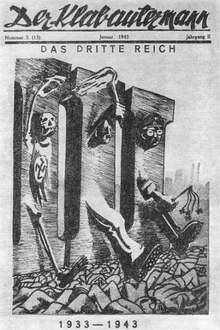
The Home Army supplied valuable intelligence to the Allies; 43% of all reports received by the British secret services from continental Europe in between 1939 and 1945 came from Polish sources.[9] Until 1942 most British intelligence on Germany came from Home Army reports. Until the end of the war, the Home Army remained Britain's main source of news from Central and Eastern Europe.[10]
Home Army intelligence provided the Allies with information on German concentration camps[11] and on the V-1 flying bomb and V-2 rocket.[2][5] In one Project Big Ben mission (Operation Wildhorn III;[12] Polish cryptonym: Most III, "Bridge III"), a stripped-for-lightness RAF twin-engine Dakota flew from Brindisi in Italy to an abandoned German airfield in Poland to pick up intelligence prepared by Polish aircraft-designer Antoni Kocjan, including 100 lb (45 kg) of V-2 rocket wreckage from a Peenemünde launch, a Special Report 1/R, no. 242, photographs, eight key V-2 parts, and drawings of the wreckage.[13]
Sabotage was coordinated by the Union of Retaliation and later by Wachlarz and Kedyw units.[3]
The Home Army also conducted psychological warfare. Its "Operation N" created the illusion of a German movement of opposition to Hitler within Germany itself.[2] Later Operation Antyk opposed Communist propaganda.[14]
Information and propaganda
The Home Army published a weekly Biuletyn Informacyjny (Information Bulletin), with a top circulation (in November 1943) of 50,000.[15][16]
Major operations

Major Home Army military and sabotage operations included:
- the Zamość Rising of 1942–43, with the Home Army sabotaging German plans to expel Poles under Generalplan Ost[3]
- protection of the Polish population from the massacres of Poles in Volhynia in 1943–44[3]
- Operation Garland, in 1942, sabotaging German rail transport[3]
- Operation Ribbon in 1943, a series of attacks on German border outposts on the frontier between the General Government and the territories annexed by Germany
- Operation Jula, in 1944, another rail-sabotage operation[3]
- most notably Operation Tempest, in 1944, a series of nationwide risings which aimed primarily to seize control of cities and areas where German forces were preparing defenses against the Soviet Red Army, so that Polish underground civil authorities could take power before the arrival of Soviet forces.[17]

The largest and best-known of the Operation Tempest battles, the Warsaw Uprising, constituted an attempt, beginning on 1 August 1944, to liberate Poland's capital. Polish forces took control of substantial parts of the city and resisted the German-led forces until 2 October (a total of 63 days). With the Poles receiving no aid from the approaching Red Army, the Germans eventually defeated the insurrectionists and burned the city, finally quelling the Uprising on 2 October 1944.[2] Other major Home Army city risings included Operation Ostra Brama, in Wilno, and the Lwów Uprising. The Home Army also prepared for a rising in Kraków, but due to various circumstances it was canceled. While the Home Army managed to liberate a number of places from German control—for example in the Lublin area, where regional structures were able to set up a functioning government—ultimately, due to Soviet hostility, the Home Army failed to secure sufficient territory to enable the Government in Exile to return to Poland.[2][3][17]
Estimates of Axis fatalities due to operations by the Polish underground, of which the Home Army formed the bulk, range up to 150,000[18][19] (however, estimates of guerrilla-inflicted casualties often have a wide margin of error[20]). The Home Army primarily focused on sabotage of German rail- and road-transports to the Eastern Front in the Soviet Union.[5][21] It is estimated that an eighth of all German transports to the Eastern Front were destroyed or substantially delayed due to Home Army operations.[21] The Poles' battles with the Germans, particularly in 1943 and 1944, tied down several German divisions (upper estimates suggest a total of some 930,000 German soldiers).[5][22]
Confirmed sabotage and covert operations of the Armed Resistance (ZWZ) and Home Army (AK)
from 1 January 1941 to 30 June 1944, listed by type[23]Sabotage / covert-operation type Total numbers Damaged locomotives 6,930 Damaged railway wagons 19,058 Delayed repairs to locomotives 803 Derailed transports 732 Transports set on fire 443 Blown-up railway bridges 38 Disruptions to electricity supply in the Warsaw grid 638 Damaged or destroyed army vehicles 4,326 Damaged aeroplanes 28 Destroyed fuel-tanks 1,167 Destroyed fuel (in tonnes) 4,674 Blocked oil wells 5 Destroyed wood wool wagons 150 Burned down military stores 130 Disruptions in factory production 7 Built-in flaws in aircraft engines parts 4,710 Built-in flaws in cannon muzzles 203 Built-in flaws in artillery projectiles 92,000 Built-in flaws in air-traffic radio stations 107 Built-in flaws in condensers 70,000 Built-in flaws in electro-industrial lathes 1,700 Damage to important factory machinery 2,872 Acts of sabotage 25,145 Assassinations of Nazi Germans 5,733
Assassinations of Nazi leaders
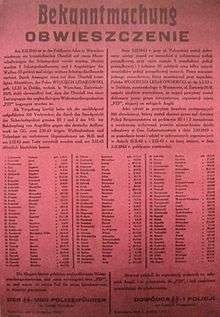
The Polish resistance conducted dozens of attacks on German commanders in occupied Poland. The largest series of assassinations was codenamed Operation Heads. Several dozen death sentences were carried out, the best-known cases being:[24]
- Operation Adolf Hitler (an attempt to blow up Hitler during his 5 October 1939 Warsaw victory parade) failed when the half-ton explosive charge failed to detonate.[25]
- Operation Kutschera—Franz Kutschera, SS-Brigadeführer and Generalmajor of Ordnungspolizei; SS and Police Leader of the Warsaw District, assassinated 1 February 1944.[26]
- Operation Bürkl—Franz Bürkl , SS-Oberscharführer, Gestapo officer, and commandant of the Pawiak prison, assassinated 7 September 1943.[27]
- Operation Freudenthal—Karl Freudenthal, SS officer who in 1941 had been made Kreishauptmann (District Head) of Garwolin County.[28]
- Operation Wilhelm Koppe failed.
Postwar
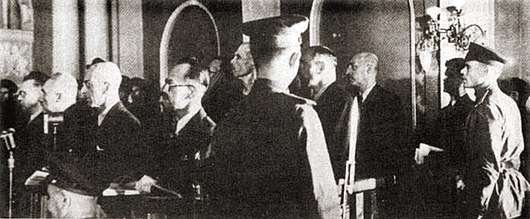
The Home Army was officially disbanded on 19 January 1945 to avoid civil war and armed conflict with the Soviets.[23] However, many former Home Army units decided to continue operations. The Soviet Union, and the Polish Communist Government that it controlled, viewed the underground, still loyal to the Polish Government-in-Exile, as a force to be extirpated before they could gain complete control of Poland. Future Secretary General of the Polish United Workers' Party, Władysław Gomułka, is quoted as saying: "Soldiers of the AK are a hostile element which must be removed without mercy." Another prominent Polish communist, Roman Zambrowski, said that the Home Army had to be "exterminated."[29]
The first Home Army structure designed primarily to deal with the Soviet threat had been NIE, formed in mid-1943. Its aim was not to engage Soviet forces in combat, but to observe them and to gather intelligence while the Polish Government-in-Exile decided how to deal with the Soviets; at that time, the exiled government still believed in the possibility of constructive negotiations with the Soviets. On 7 May 1945 NIE ("NO") was disbanded[29] and transformed into an Armed Forces Delegation for Poland (Delegatura Sił Zbrojnych na Kraj); but this organization lasted only until 8 August 1945, when it was decided to disband it and to stop partisan resistance.[29]
The first Polish communist government, the Polish Committee of National Liberation, formed in July 1944, declined to accept jurisdiction over Home Army soldiers, therefore for over a year Soviet agencies such as the NKVD took responsibility for disarming the Home Army.[29] By war's end, some 60,000 Home Army soldiers had been arrested, 50,000 of whom were deported to Soviet Gulags and prisons; most of these soldiers had been taken captive by the Soviets during, or in the aftermath of, Operation Tempest, when many Home Army units tried to work together with the Soviets in a nationwide uprising against the Germans.[29] Other Home Army veterans were arrested when they approached Polish communist government officials after having been promised amnesty. After a number of such broken promises during the first few years of communist control, Home Army soldiers stopped trusting the government.[29]
The third post-Home Army organization was Wolność i Niezawisłość (WiN: Freedom and Independence). Its primary goal was not combat, either. Rather, it was designed to help Home Army soldiers transition from partisan to civilian life; while secrecy was necessary in the light of increasing persecution of Home Army veterans by the communist government.[30] WiN was, however, in great need of funds, necessary to pay for false documents and to provide resources for the partisans, many of whom had lost their homes and life's savings in the war. Viewed as enemies of the state, starved of resources, and with a vocal faction advocating armed resistance against the Soviets and their Polish proxies, WiN was far from efficient.[29] A major victory for the Soviet NKVD and the newly created Polish secret police, Urząd Bezpieczeństwa (UB), came in the second half of 1945, when they managed to convince several Home Army and WiN leaders that they truly wanted to offer amnesty to Home Army members. Over a few months they gained information about great numbers of Home Army and WiN people and resources. By the time the (imprisoned) Home Army and WiN leaders realized their mistake, the organizations had been crippled, with thousands of their members arrested.[29] WiN was finally disbanded in 1952. By 1947 a colonel of the communist forces declared that "The terrorist and political underground has ceased to be a threatening force, though there are still men of the forests" to be dealt with.[29]
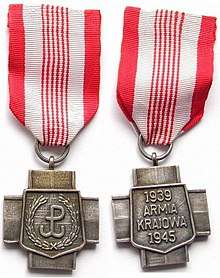
The persecution of the Home Army was only part of the Stalinist repressions in Poland. In the period 1944–56, some 2 million people were arrested,[29] over 20,000, including the hero of Auschwitz, Witold Pilecki, were executed or murdered in communist prisons,[29] and 6 million Polish citizens (every third adult Pole) were classified as "reactionary" or "criminal elements" and subjected to spying by state agencies.[29]
Most Home Army soldiers were captured by the NKVD or by Poland's UB political police. They were interrogated and imprisoned on various charges such as "fascism".[31][32] Many were sent to Gulags, executed or "disappeared."[31] Thus, between 1944 and 1956 all the members of Batalion Zośka, which had fought in the Warsaw Uprising, were locked up in communist prisons.[33] In 1956 an amnesty released 35,000 former Home Army soldiers from prisons: some had spent over 10 years imprisoned for the crime of fighting for their country.
Even then, however, some partisans remained in the countryside, unwilling or unable to rejoin the community; they became known as the cursed soldiers. Stanisław Marchewka "Ryba" was killed in 1957, and the last AK partisan, Józef Franczak "Lalek," was killed in 1963[29] – almost 2 decades after World War II had ended. It was only four years later, in 1967, that Adam Boryczka, a soldier of AK and a member of the elite, Britain-trained Cichociemny ("Silent Unseen") intelligence and support group, was released from prison. Until the end of the People's Republic of Poland, Home Army soldiers remained under investigation by the secret police, and it was only in 1989, after the fall of communism, that the sentences of Home Army soldiers were finally declared null and void by Polish courts.[29]
Many monuments to the Home Army have since been erected in Poland, including the Polish Underground State and Home Army Monument near the Sejm building in Warsaw, unveiled in 1999.[34][35] The Home Army is also commemorated in the Home Army Museum in Kraków[36] and in the Warsaw Uprising Museum in Warsaw.[37]
Membership

In February 1942, when the Home Army was formed from the Armed Resistance, it numbered some 100,000 members.[6] Less than a year later, at the start of 1943, it had reached a strength of some 200,000.[6] In the summer of 1944, when Operation Tempest began, the Home Army reached its highest membership.[6] Estimates of membership in the first half and summer of 1944 range from 200,000,[7]:234 through 300,000,[38] 380,000[6] and 400,000 to [5] 450,000–500,000.[39] Most estimates average at about 400,000. The strength estimates vary due to the constantly ongoing integration of other resistance organizations into the Home Army; and due to the fact that, while the number of members was high and that of sympathizers was much higher still, the number of armed members participating in operations was smaller due to insufficient number of weapons.[6][20][7]:234
Home Army numbers in 1944 include a cadre of over 10,000–11,000 officers, 7,500 officers-in-training (singular: podchorąży) and 88,000 non-commissioned officers (NCOs).[6] The officer cadre was formed from prewar officers and NCOs, graduates of underground courses, and elite operatives usually parachuted in from the West (the Silent Unseen).[6] The basic organizational unit was the platoon, numbering 35–50 people, with a skeleton unmobilized version of 16–25; in February 1944 the Home Army had 6,287 regular and 2,613 skeleton platoons operational.[6] Such numbers made the Home Army not only the largest Polish resistance movement, but one of the two largest in World War II Europe [a]. Casualties during the war are estimated at about 34,000[38]-100,000,[6] plus some 20,000[38]-50,000[6] after the war (casualties and imprisonment).
Within the framework of the entire enemy intelligence operations directed against Germany, the intelligence service of the Polish resistance movement assumed major significance. The scope and importance of the operations of the Polish resistance movement, which was ramified down to the smallest splinter group and brilliantly organized, have been in [various sources] disclosed in connection with carrying out of major police security operations. — Heinrich Himmler, 31 December 1942 [40]
The Home Army was intended as a mass organization, founded by a core of prewar officers.[6] Home Army soldiers fell into three groups. The first two consisted of "full-time members": undercover operatives, living mostly in urban settings under false identities (most senior Home Army officers belonged to this group); and uniformed (to a certain extent) partisans, living in forested regions (see "forest people"), who openly fought the Germans (the forest people are estimated at some 40 groups, numbering 1,200–4,000 persons in early 1943, but their numbers grew substantially during Operation Tempest).[7]:234-235 The third, largest group were "part-time members": sympathizers who led "double lives" under their real names in their real homes, received no payment for their services, stayed in touch with their undercover unit commanders but were seldom mustered for operations, as the Home Army planned to use them only during a planned nationwide rising.[7]:234-235
The Home Army was intended to be representative of the Polish nation, its members being recruited from all parties and social classes (the only notable exception being communists sent by the Soviets, and the Soviet-created People's Army).[7]:235-236 The Home Army's growth was largely based on integrating, into its ranks, scores of smaller resistance organizations. Most other Polish underground armed organizations were incorporated into the Home Army (though they retained varying degrees of autonomy).[3][5] The largest organization merged into the Home Army was the leftist Bataliony Chłopskie (Peasants' Battalions), about 1943-44.[41] Parts of the Narodowe Siły Zbrojne (National Armed Forces) also came to be subordinated to the Home Army.[42] As a result, individual Home Army units varied substantially in their political outlooks (notably in their attitudes toward ethnic minorities and toward the Soviets).[7]:235-236 The largest group that completely refused to join the Home Army was the pro-Soviet, communist People's Army, which at its height in 1944 numbered 30,000 people.[43]
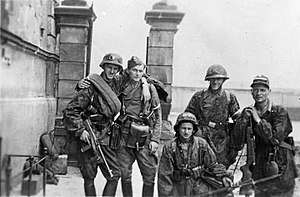
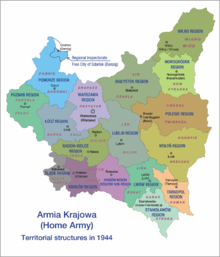
Structure
Home Army Headquarters was divided into five sections, two bureaus and several other specialized units:[2][6]
- Section I: Organization – personnel, justice, religion
- Section II: Intelligence and Counterintelligence
- Section III: Operations and Training – coordination, planning, preparation for a nationwide uprising
- Section IV: Logistics
- Section V: Communication – including with the Western Allies; air drops
- Bureau of Information and Propaganda (sometimes called "Section VI") – information and propaganda
- Bureau of Finances (sometimes called "Section VII") – finances
- Kedyw (acronym for Kierownictwo Dywersji, Polish for "Directorate of Diversion") – special operations
- Directorate of Underground Resistance
The Home Army's commander was subordinate in the military chain of command to the Polish Commander-in-Chief (General Inspector of the Armed Forces) of the Polish Government in Exile[6] and answered in the civilian chain of command to the Government Delegation for Poland.
The Home Army's first commander, until his arrest by the Germans in 1943, was Stefan Rowecki (nom de guerre "Grot", "Spearhead").
Tadeusz Bór-Komorowski (Tadeusz Komorowski, nom de guerre "Bór", "Forest") commanded from July 1943 until his surrender to the Germans, upon the suppression of the Warsaw Uprising, in October 1944.
Leopold Okulicki, nom de guerre "Niedzwiadek" ("Bear"), led the Home Army in its final days.[2]
| Name | Codename | Period | Replaced because | Fate | Photo | |
|---|---|---|---|---|---|---|
| 1. | General Michał Karaszewicz-Tokarzewski Technically, commander of Służba Zwycięstwu Polski and Związek Walki Zbrojnej as AK was not named such until 1942 |
Torwid | 27 September 1939 – March 1940 | Arrested by the Soviets | Joined the Anders Army, fought in the Polish Armed Forces in the West. Emigrated to the United Kingdom. | |
| 2. | General Stefan Rowecki | Grot | 18 June 1940 – 30 June 1943 | Discovered and arrested by German Gestapo | Imprisoned in Sachsenhausen concentration camp. Executed by personal decree of Heinrich Himmler after Warsaw Uprising has started. | 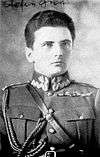 |
| 3. | General Tadeusz Komorowski | Bór | July 1943 – 2 September 1944 | Surrendered after the end of Warsaw Uprising. | Emigrated to United Kingdom. | 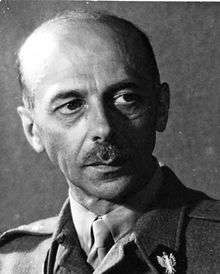 |
| 4. | General Leopold Okulicki | Niedźwiadek | 3 October 1944 – 17 January 1945 | Dissolved AK trying to lessen the Polish-Soviet tensions. | Arrested by the Soviets, sentenced for imprisonment in the Trial of the Sixteen. Likely executed in 1946. | 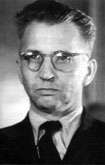 |
Regions
The Home Army was divided geographically into regional branches or areas (obszar).[2] Below the branches or areas were subregions or subareas (podokręg) or independent areas (okręgi samodzielne). Smaller organizational units were 89 inspectorates (inspektorat) and 280 (as of early 1944) districts (obwód).[6] Overall, the Home Army regional structure largely resembled Poland's interwar administration division, with an okręg being similar to a voivodeship (see Administrative division of Second Polish Republic).[6]
There were three to five areas: Warsaw (Obszar Warszawski, with some sources differentiating between left- and right-bank areas – Obszar Warszawski prawo- i lewobrzeżny), Western (Obszar Zachodni, in the Pomerania and Poznań regions), Southeastern (Obszar Południowo-Wschodni, in the Lwów area); sources vary on whether there was a Northeastern Area (centered in Białystok – Obszar Białystocki) or whether Białystok was classified as an independent area (Okręg samodzielny Białystok).
| Area | Districts | Codenames | Units (re)created during the reconstruction of the Polish Army in Operation Tempest |
|---|---|---|---|
| Warsaw area Codenames: Cegielnia (Brickworks), Woda (Water), Rzeka (River) Warsaw Col. Albin Skroczyński Łaszcz |
Eastern Warsaw-Praga Col. Hieronim Suszczyński Szeliga |
Struga (stream), Krynica (source), Gorzelnia (distillery) | 10th Infantry Division |
| Western Warsaw Col. Franciszek Jachieć Roman |
Hallerowo (Hallertown), Hajduki, Cukrownia (Sugar factory) | 28th Infantry Division | |
| Northern Warsaw Lt. Col. Zygmunt Marszewski Kazimierz |
Olsztyn, Tuchola, Królewiec, Garbarnia (tannery) | 8th Infantry Division | |
| South-Eastern area Codenames: Lux, Lutnia (lute), Orzech (nut) Lwów Col. Władysław Filipkowski Janka |
Lwów Lwów – divided into two areas Okręg Lwów Zachód (West) and Okręg Lwów Wschód (East) Col. Stefan Czerwiński Luśnia |
Dukat (ducat), Lira (lire), Promień (ray) | 5th Infantry Division |
| Stanisławów Stanisławów Capt. Władysław Herman Żuraw |
Karaś (crucian carp), Struga (stream), Światła (lights) | 11th Infantry Division | |
| Tarnopol Tarnopol Maj. Bronisław Zawadzki |
Komar (mosquito), Tarcza (shield), Ton (tone) | 12th Infantry Division | |
| Western area Codename: Zamek (Castle) Poznań Col. Zygmunt Miłkowski Denhoff |
Pomerania Gdynia Col. Janusz Pałubicki Piorun |
Borówki (berries), Pomnik (monument) | |
| Poznań Poznań Col. Henryk Kowalówka |
Pałac (palace), Parcela (lot) | ||
| Independent areas | Wilno Wilno Col. Aleksander Krzyżanowski Wilk |
Miód (honey), Wiano (dowry) (subunit "Kaunas Lithuania") | |
| Nowogródek Nowogródek Lt.Col. Janusz Szlaski Borsuk |
Cyranka (garganey), Nów (new moon) | Zgrupowanie Okręgu AK Nowogródek | |
| Warsaw Warsaw Col. Antoni Chruściel Monter |
Drapacz (sky-scraper), Przystań (harbour), Wydra (otter), Prom (shuttle) |
||
| Polesie Pińsk Col. Henryk Krajewski Leśny |
Kwadra (quarter), Twierdza (keep), Żuraw (crane) | 30th Infantry Division | |
| Wołyń Równe Col. Kazimierz Bąbiński Luboń |
Hreczka (buckwheat), Konopie (hemp) | 27th Infantry Division | |
| Białystok Białystok Col. Władysław Liniarski Mścisław |
Lin (tench), Czapla (aigrette), Pełnia (full moon) | 29th Infantry Division | |
| Lublin Lublin Col. Kazimierz Tumidajski Marcin |
Len (linnen), Salon (saloon), Żyto (rye) | 3rd Legions' Infantry Division 9th Infantry Division | |
| Kraków Kraków various commanders, incl. Col. Julian Filipowicz Róg |
Gobelin, Godło (coat of arms), Muzeum (museum) | 6th Infantry Division 106th Infantry Division 21st Infantry Division 22nd Infantry Division 24th Infantry Division Kraków Motorized Cavalry Brigade | |
| Silesia Katowice various commanders, incl. Col. Zygmunt Janke Zygmunt |
Kilof (pick), Komin (chimney), Kuźnia (foundry), Serce (heart) | ||
| Kielce-Radom Kielce, Radom Col. Jan Zientarski Mieczysław |
Rolnik (farmer), Jodła (fir) | 2nd Legions' Infantry Division 7th Infantry Division | |
| Łódź Łódź Col. Michał Stempkowski Grzegorz |
Arka (ark), Barka (barge), Łania (bath) | 25th Infantry Division 26th Infantry Division | |
| Foreign areas | Hungary Budapest Lt.Col. Jan Korkozowicz |
Liszt | |
| Reich Berlin |
Blok (block) |
In 1943 the Home Army began recreating the organization of the prewar Polish Army, its various units now being designated as platoons, battalions, regiments, brigades, divisions, and operational groups.[6]
Weapons and equipment
As a clandestine army operating in an enemy-occupied country, and separated by over a thousand kilometers from any friendly territory, the Home Army faced unique challenges in acquiring arms and equipment.[44] It was able to overcome these difficulties to some extent and to field tens of thousands of armed soldiers. Nevertheless, the difficult conditions meant that only infantry forces armed with light weapons could be fielded. Any use of artillery, armor or aircraft was impossible (except for a few instances during the Warsaw Uprising, such as the Kubuś armored car).[44] Even these light-infantry units were as a rule armed with a mixture of weapons of various types, usually in quantities sufficient to arm only a fraction of a unit's soldiers.[20][7]:234[44]
Home Army arms and equipment came mostly from four sources: arms that had been buried by the Polish armies on battlefields after the 1939 invasion of Poland; arms purchased or captured from the Germans and their allies; arms clandestinely manufactured by the Home Army itself; and arms received from Allied air drops.[44]
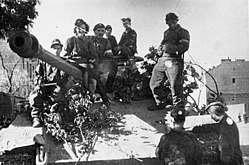
From arms caches hidden in 1939, the Home Army obtained: 614 heavy machine guns, 1,193 light machine guns, 33,052 rifles, 6,732 pistols, 28 antitank light field guns, 25 antitank rifles, and 43,154 hand grenades.[45] However, due to their inadequate preservation, which had had to be improvised in the chaos of the September Campaign, most of the guns were in poor condition. Of those that had been buried in the ground and had been dug up in 1944 during preparations for Operation Tempest, only 30% were usable.[46]
Sometimes arms were purchased on the black market from German soldiers or their allies, or stolen from German supply depots or transports.[44] Purchases were made by individual units and sometimes by individual soldiers. As Germany's prospects for victory diminished and the morale in German units dropped, the number of soldiers willing to sell their weapons correspondingly increased and thus made this source more important.[46] All such purchases were highly risky, as the Gestapo was well aware of this black market in arms and tried to check it by setting up sting operations. For the most part this trade was limited to personal weapons, but occasionally light and heavy machine guns could also be purchased. It was much easier to trade with Italian and Hungarian units stationed in Poland, which more willingly sold their arms to the Polish underground as long as they could conceal this trade from the Germans.[46]
Efforts to capture weapons from the Germans also proved highly successful. Raids were conducted on trains carrying equipment to the front, as well as on guardhouses and gendarmerie posts. Sometimes weapons were taken from individual German soldiers accosted in the street. During the Warsaw Uprising, the Home Army even managed to capture several German armored vehicles.[46]

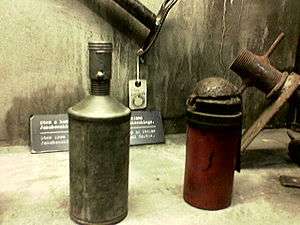
Arms were clandestinely manufactured by the Home Army in its own secret workshops, and also by Home Army members working in German armaments factories.[44][46] In this way the Home Army was able to procure submachine guns (copies of British Stens, indigenous Błyskawicas and KIS), pistols (Vis), flamethrowers, explosive devices, road mines, and Filipinka and Sidolówka hand grenades.[44] Hundreds of people were involved in the manufacturing effort. The Home Army did not produce its own ammunition, but relied on supplies stolen by Polish workers from German-run factories.[44]
The final source of supply was Allied air drops. This was the only way to obtain more exotic, highly useful equipment such as plastic explosives and antitank weapons such as the British PIAT. During the war, 485 air-drop missions from the West (about half of them flown by Polish airmen) delivered some 600 tons of supplies for the Polish resistance.[47] Besides equipment, the planes also parachuted in highly qualified instructors (Silent Unseen), 316 of whom[38] were inserted into Poland during the war.[45]
But the air drops were too little, too late. Air deliveries from the west were limited by Stalin's refusal to let the planes land on Soviet territory; by the low priority placed by the British on flights to Poland; and by extremely heavy losses sustained by Polish Special Duties Flight personnel. Especially after Hitler attacked the Soviet Union in June 1941 and the Soviets joined the Western Allies in the war against Germany, Britain and the United States attached more importance to not antagonizing Stalin than they did to the aspirations of the Poles to regain their national sovereignty.[48]
In the end, despite all the efforts, most Home Army forces had inadequate weaponry. In 1944, when the Home Army was at its peak strength (200,000–600,000, according to various estimates), the Home Army had enough weaponry for only some 32,000 soldiers."[7]:234 On 1 August 1944, when the Warsaw Uprising began, only a sixth of Home Army fighters in Warsaw were armed.[7]:234
Relations with other groups
Relations with Jews
Home Army members' attitudes toward Jews varied widely from unit to unit, and the topic remains controversial.[49][50][51]
Daily operations
Many members of the Home Army were Jews, especially in leadership positions[52] (for example Marceli Handelsman,[53] Jerzy Makowiecki[53] and Ludwik Widerszal[53]) but also in the field (like Julian Aleksandrowicz,[54] Stanisław "Shlomo" Aronson,[55] Alicja Gołod-Gołębiowska,[56] and Leon Kopelman,[57]). Several detachment of Jewish partisans were formed under Home Army; one during the Warsaw Uprising.[58][59] and another one in Hanaczów.[60][61]:317 Home Army provided training and supplies to Warsaw Ghetto's Jewish Combat Organization.[60] It is estimated that thousands of Jews served in the Home Army.[62]:275 The Home Army answered to the National Council of the Polish Government in Exile, where some Jews served in leadership positions (eg. Ignacy Schwarzbart and Szmul Zygielbojm)[63] (though there were no Jewish representatives in the Government Delegation for Poland).[64]:110–114 Nevertheless, some historians have asserted that the Home Army was reluctant to accept Jews into its ranks due to antisemitism.[65]
In February 1942, the Home Army Operational Command's Office of Information and Propaganda set up a Section for Jewish Affairs, directed by Henryk Woliński.[66] This section collected data about the situation of the Jewish population, drafted reports, and sent information to London. It also centralized contacts between Polish and Jewish military organizations. The Home Army also supported the Relief Council for Jews in Poland (Żegota) as well as the formation of Jewish resistance organizations.[67][68][69]
The Holocaust
In 1942 the Home Army sent Jan Karski to personally deliver the first eyewitness account of the Holocaust to the Western powers, after having personally visited the Warsaw Ghetto and a Nazi concentration camp.[64]:110–114[70]
Witold Pilecki, a member of the Home Army, was the only person to volunteer to be imprisoned at Auschwitz. The information that he gathered proved crucial in convincing the Western Allies about the fate of the Jewish population.[11]
Starting in May 1943 the Home Army started carrying out death sentences for szmalcowniks in Warsaw.[71] According to Władysław Bartoszewski, despite the fact that the Home Army carried out more death sentences on blackmailers than any other resistance organization in occupied Europe, these death sentences did not have a significant effect on the scale of blackmail and denunciation because of the difficulty of tracking down extortionists.[72]
In Mach 1943 underground reports from the Home Army provided reports of German genocide against Jews and Poles. General Rowecki estimated that 640,000 people had perished in Auschwitz between 1940 and March 1943, including 66,000 ethnic Poles and 540,000 Jews from various countries(this figure was revised later to 500,000)[61]:188.
Based on an order issued by General Stefan Grot-Rowecki, several historians have concluded that the Home Army did not view Jews as part of the Polish nation, and was reluctant to prevent their genocide.[73][52]:65-66 The order states that no action is to be taken to defend Jewish lives if it endangered other objectives of the Home Army.[74] Rowecki's attitude shifted in the following months as the brutal reality of the Holocaust became more apparent, and the Polish public support for the Jewish resistance increased. Rowecki was willing to provide Jewish fighters with aid and resources when it contributed to "the greater war effort", but had (apparently) concluded that providing large quantities of supplies to the Jewish resistance would be futile. This reasoning was the norm among the Allies, who believed that the Holocaust could only be halted by a significant military action.[64]:110-122
The Warsaw ghetto uprising
The Home Army provided the Warsaw Ghetto with firearms, ammunition and explosives.[67][49] but only after it was convinced of the Jewish Combat Organization's eagerness to fight,[52]:67 and after intervention by Władysław Sikorski on the organization's behalf.[75] Zimmerman describes the supplies as "limited but real".[64]:121-122 Jewish fighters of the Jewish Military Union received from the Home Army, among other things: 2 heavy machine guns, 4 light machine guns, 21 submachine guns, 30 rifles, 50 pistols, and over 400 grenades.[76] Jewich Combat Organization received from AK: 10 pistols, 3 light machine gun, 10 rifles, 50 pistols - all with ammunition, 600 grenades, 150 kilograms of explosives as well as potassium and nitrate for their production. For comparison, AK before the Warsaw Ghetto Uprising had in the District of Warsaw some 25 heavy machine guns, 62 lights machine guns, 1,182 rifles, 1,099 pistols, 51 submachine guns, 2 cannons 75, 3 anti-tank cannons, 3 anti-tank guns and 11,007 hand grenades.[77] According to that the limited assistance given by AK's to the Jewish resistance organization stemmed from its inability to arm its own troops, from the view that any wide-scale uprising in 1943 would be futile, and from the pro-Soviet attitude of the ŻOB.[78] During the 1943 Warsaw Ghetto Uprising, Home Army units twice tried to blow up the Ghetto wall, carried out diversionary actions outside the Ghetto walls, and attacked German sentries sporadically near the Ghetto walls. The Security Cadre (Kadra Bezpieczeństwa, or K.B.), an organization subordinate to the Home Army, commanded by Henryk Iwański, took part in the fighting inside the Ghetto together with Jewish fighters of the Jewish Military Union (Żydowski Związek Walki, or Ż.Z.W.)[49] and the Jewish Combat Organization (Żydowska Organizacja Bojowa, or Ż.O.B.).[79] According to Polish-Jewish historian and former director of the Jewish Historical Institute in Warsaw Marian Fuks without the support of Polish Home Army, the Ghetto uprising wouldn't be possible[80]
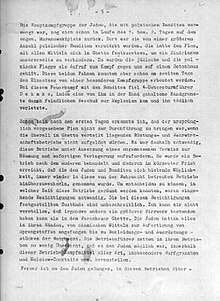
Jürgen Stroop, in charge of the German efforts to liquidate the Warsaw Ghetto, wrote in his report:
When we invaded the Ghetto for the first time, the Jews and the Polish bandits succeeded in repelling the participating units, including tanks and armored cars, by a well-prepared concentration of fire. [...] The main Jewish battle group, mixed with Polish bandits, had already retired during the first and second day to the so-called Muranowski Square. There it was reinforced by a considerable number of Polish bandits. Its plan was to hold the Ghetto by every means in order to prevent us from invading it. [...] Time and again Polish bandits found refuge in the Ghetto and remained there undisturbed, since we had no forces at our disposal to comb out this maze. [...] One such battle group succeeded in mounting a truck by ascending from a sewer in the so-called Prosta [Street], and in escaping with it (about 30 to 35 bandits). ... The bandits and Jews – there were Polish bandits among these gangs armed with carbines, small arms, and in one case a light machine gun – mounted the truck and drove away in an unknown direction.
A year later, during the 1944 Warsaw Uprising, the Zośka Battalion liberated hundreds of Jewish inmates from the Gęsiówka section of the Warsaw Concentration Camp.[67][62]:275
Attitude towards fugitives
According to Antony Polonsky the AK saw Jewish fugitives as security risks.[52]:66 At the same time, AK's "paper mills" supplied forged identification documents to many Jewish fugitives, enabling them to pass as Poles.[62]:275 Home Army published leaflet in 1943 stating that Every Pole is obligated to help those in hiding. Those who refuse them aid will be punished on the basis of...treason to the Polish Nation[61]:194
Just like there were instances of AK acting as protectors of Jews and even entire Jewish communities,[61]:346 a few AK units actively hunted down Jews.[83]:238[84] In particular, two district commanders in the east of Poland - Władysław Liniarski of Białystok and Janusz Szlaski and Nowogródek - openly and routinely persecuted Jewish partisans and fugitives.[61]:267-298 The extent of such behaviors in the Home Army overall has been disputed;[85]:88-90[86] some historians claim that the bulk of the Home Army's antisemitic behavior can be ascribed to a small minority of members,[85]:88-90 often affiliated with the far-right National Democracy (N.D., or "endecja") party, whose National Armed Forces organization was mostly integrated into the Home Army in 1944.Template:Paulsson 2002Template:Paulsson 2002 It has been suggested that some of these incidents are better understood in the context of the Polish-Soviet conflict, as some of the Soviet-affiliated partisan units that AK units attacked or was attacked by had a sizable Jewish presence[60]. In general, AK units in the east were more likely to be hostile towards Jewish partisans, who in turn were more closely associated with the Soviet underground, while AK units in the west were more helpful towards the Jews.[61] Further, AK had a more favorable attitude towards Jewish civilians, and was more hesitant or hostile towards independent Jewish partisans, whom it suspected of pro-Soviet sympathies.[61]:299General Rowecki described Jewish relation to communism as varied from region to region, with assaults by Soviets units including Jews in their ranks and killing of Poles strenghtening antisemism in Eastern Poland[61]:189.
The Home Army leadership punished perpetrators of antisemitic violence in its ranks, in some cases sentencing them to death.[85]:88-90
Most of underground press was symphathic towards Jews[87] and Home Army's Bureau of Information and Propaganda was led by leaders who were pro-Jewish and represented liberal wing of Home Army[88] Anti-Communist sub-division[89] ("Antyk"; see also Operation Antyk), was devoted to communist activity and anti-communist propaganda[90]Its creation was a response to communist propaganda campaign in Poland preparing it for Soviet takeover[91]Antyk counted 20 people and received 4% of Bureau's funds;it was deeply undecover and it's publications weren't signed by Home Army's Bureau[92].According to historian Joshua D. Zimmerman it represented leaders who held strong anti-communist and anti-Jewish views, including the zydokomuna stereotype[93] Zimmerman writes that the perceived association between Jews and communists was actively reinforced by the Home Army's Bureau of Information and Propaganda's Anti-Communist sub-department ("Antyk"), who's initial reports "tended to conflate communists with Jews, dangerously disseminating the notion that Jewish loyalties were to Soviet Russia and communism rather than to Poland," and which repeated the notion that anti-Semitism was a "useful tool in the struggle against Soviet Russia."[94][95] Zimmerman writes that "the stereotype that communism depended in large part on a Jewish elment was nonetheless believed far beyond Antyk"[96].
Recognition
Members of the Home Army that were named Righteous Among the Nations include Jan Karski, Aleksander Kamiński, Stefan Korboński, Henryk Woliński, Jan Żabiński, Władysław Bartoszewski, Mieczysław Fogg, Henryk Iwański, Witold Bieńkowski and Jan Dobraczyński.[97][98]
Relations with Lithuanians
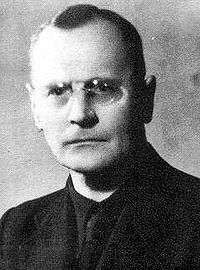
Though the Lithuanian and Polish resistance movements had common enemies—Nazi Germany and the Soviet Union—they began working together only in 1944–45, after the Soviet reoccupation, when both fought the Soviet occupiers.[99] The main obstacle to forming an alliance earlier was a long-standing territorial dispute over Vilnius (see "Żeligowski's Mutiny").[100]
Some Lithuanians, encouraged by vague German promises of Lithuanian autonomy,[85]:163 cooperated with Nazi operations against Poles during the German occupation. In autumn 1943 the Home Army opened retaliatory operations against the Nazis' Lithuanian supporters, mainly the Lithuanian Schutzmannschaft battalions, the Lithuanian Territorial Defense Force, and the Lithuanian Secret Police,[101] and killed hundreds of mostly Lithuanian policemen and other collaborators during the first half of 1944. In response, the Lithuanian police, who had already murdered hundreds of Polish civilians since 1941 (see "Ponary massacre"),[85]:168-169 intensified their operations against the Poles.
In April 1944 the Home Army in the Vilnius Region attempted to open negotiations with Povilas Plechavičius, commander of the Lithuanian Territorial Defense Force, proposing a nonaggression pact and cooperation against Nazi Germany.[102] The Lithuanian side refused and demanded that the Poles either leave the Vilnius region (disputed between Poles and Lithuanians) or subordinate themselves to the Lithuanians' struggle against the Soviets.[102] In the May 1944 Battle of Murowana Oszmianka, the Home Army dealt a substantial blow to the Lithuanian Nazi auxiliaries of the Lithuanian Territorial Defense Force.[85]:165-166[103] This resulted in a low-level civil war between anti-Nazi Poles and pro-Nazi Lithuanians, encouraged by the German authorities,[101] culminating in June 1944 massacres of Polish and Lithuanian civilians, respectively, in the villages of Glitiškės (Glinciszki) and Dubingiai (Dubinki).[85]:168-169
Postwar assessments of the Home Army's activities in Lithuania have been controversial. In 1993, the Home Army's activities there were investigated by a special Lithuanian government commission. Only in recent years have Polish and Lithuanian historians been able to approach consensus, though still differing in their interpretations of many events.[104][105]
Relations with the Soviets

Home Army relations with the Soviet Red Army became increasingly poor over the course of the war. Not only had the Soviet Union invaded Poland on 17 September 1939, following the German invasion beginning 1 September 1939, but even after the Germans invaded the Soviet Union in June 1941 the latter saw Polish partisans loyal to the Polish Government in Exile more as a potential obstacle to Soviet plans to take control of postwar Poland, than as a potential ally.[106] On orders from the Soviet Stavka (high command), issued on 22 June 1943,[85]:98-99 Soviet partisans engaged Polish partisans in combat, and it has been claimed that they attacked the Poles more often than they did the Germans.[106]
In late 1943 the actions of Soviet partisans, who had been ordered to destroy Home Army forces,[85]:98-99 even resulted in limited uneasy cooperation between some Home Army units and German forces.[85]:88-90 While the Home Army still treated the Germans as the enemy and conducted operations against them,[85]:88-90 when the Germans offered arms and supplies to the Home Army, to be used against the Soviet partisans, some Polish units in the Nowogródek and Wilno areas accepted them. However, such arrangements were purely tactical and indicated no ideological collaboration such as was shown by France's Vichy regime or Norway's Quisling regime.[85]:88-90 The Poles' main motive was to acquire intelligence on the Germans and to obtain much-needed equipment.[50] There were no known joint Polish-German operations, and the Germans were unsuccessful in recruiting the Poles to fight exclusively against the Soviet partisans.[85]:88-90 Furthermore, most such cooperation by local Home Army commanders with the Germans was condemned by Home Army headquarters.[85]:88-90 Tadeusz Piotrowski quotes Joseph Rothschild as saying that "The Polish Home Army was by and large untainted by collaboration", and as adding that "the honor of the AK as a whole is beyond reproach."[85]:88-90
With the Eastern Front entering Polish territories in 1944, the Home Army established an uneasy truce with the Soviets. Even so, the main Red Army and NKVD forces conducted operations against Home Army partisans, including during or directly after Poland's Operation Tempest, which the Poles had envisioned to be a joint Polish-Soviet operation against the retreating Germans which would also establish Polish claims to those territories.[5][29] The Home Army helped Soviet units with scouting assistance, uprisings, and assistance in liberating some cities (e.g., Operation Ostra Brama in Vilnius, and the Lwów Uprising), only to find that immediately afterwards Home Army troops were arrested, imprisoned –even executed.[21] Unknown to the Poles, their Operation Tempest had been fatally flawed from the start due to Joseph Stalin's intention of ensuring that an independent Poland would never re-emerge after the war.[107]
Long after the war, Soviet forces continued engaging elements of the Home Army. Many Home Army soldiers continued their war in an anti-Soviet Polish underground known as the "cursed soldiers".[29]
Relations with Ukrainians

The Ukrainian Insurgent Army (UPA), a Ukrainian nationalist force and the military arm of the Organization of Ukrainian Nationalists (OUN),[108] which is considered by some historians as fascist,[109] while fighting the Germans, the Soviets and the Poles, whom they saw as occupiers of the future ethnically-pure Ukrainian state,[110] decided in 1943 to direct most of their attacks against the Poles and the Polish Jews.[110] One of UPA's leaders, Stepan Bandera, and his followers concluded that the war would end in the exhaustion of both Germany and the Soviet Union, and that therefore the Poles, who also laid claim to East Galicia (viewed by the Ukrainians as Western Ukraine, and by the Poles as Eastern Poland), had to be weakened before Poland arose again.[111] Some Ukrainian groups' collaboration with Nazi Germany (though declining in 1943) had discredited Ukrainian partisans as potential Polish allies; Polish plans to restore prewar Poland's borders were opposed by the Ukrainians.[111]
The OUN decided to attack Polish civilians, who constituted about a third of the population of the disputed territories.[111] The OUN equated Ukrainian independence with ethnic homogeneity; the Polish presence had to be removed completely.[111] By February 1943 the OUN began a deliberate campaign of murdering Polish civilians.[111] OUN forces targeted Polish villages, prompting the formation of Polish self-defense units (e.g., the Przebraże Defence) and fights between the Home Army and the OUN.[111] The Germans encouraged both sides against each other; Erich Koch said: "We have to do everything possible so that a Pole, when meeting a Ukrainian, will be ready to kill him, and conversely, a Ukrainian will be ready to kill the Pole." A German commissioner from Sarny, when local Poles complained about massacres, answered: "You want Sikorski, the Ukrainians want Bandera. Fight each other."[112] In massacres of Poles in Volhynia and Eastern Galicia, beginning in the spring of 1943 100,000 Poles were killed.[113][114][115]
The Polish Government-in-Exile, in London, was taken by surprise; it had not expected Ukrainian anti-Polish actions of such magnitude.[111] There is no evidence that the Polish Government-in-Exile contemplated a general policy of revenge against the Ukrainians, but local Poles, including Home Army commanders, engaged in retaliatory actions.[111] Polish partisans attacked the OUN, assassinated Ukrainian commanders, and carried out operations against Ukrainian villages.[111] The Home Army command tried to limit operations against Ukrainian civilians to a minimum.[116] According to Grzegorz Motyka, the Polish operations resulted in 10,000 to 15,000 Ukrainian deaths in 1943-47,[117] including 8,000-10,000 on territory of post-war Poland.[118][119] By winter 1943 and spring 1944 the Home Army was preparing for Operation Tempest, one of whose goals was strengthening the Polish position in Volhynia. In January 1944 the 27th Home Army Infantry Division was formed, numbering 7,000 men, purposed to defend Polish civilians and engage the OUN and German forces.[111]
By mid-1944, the region was occupied by the Soviet Red Army. Polish partisans disbanded or went underground, as did most Ukrainian partisans. Both the Poles and the Ukrainians would increasingly concentrate on the Soviets as their primary enemy – and both would ultimately fail.[111]
Volhynia
After the first murders, the Polish underground began organizing self-defense.[120] The commander of the Home Army Wołyń District, Col. Kazimierz Bąbiński, "Luboń", forbade reprisals against Ukrainians.[121] On 10 July 1943, Zygmunt Rumel was sent to talk with local Ukrainians, with the goal of ending the massacres. The mission was unsuccessful; the Banderites killed the Polish delegation.[122] On 15 July 1943 the Home Army planned to carry out an operation to liquidate the OUN-B members and thus thwart anti-Polish actions. However, it was incorrectly assumed that the action was planned for 20 July.[123] On 20 July the Home Army command decided to establish partisan units in Volhynia. Nine troops were created, numbering about a thousand soldiers.[124] The Home Army also liquidated individual Ukrainians who were suspected of sympathizing with the Ukrainian nationalists.[125]
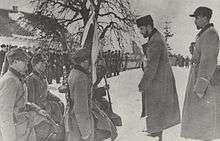
In January 1944 the 27th Home Army Infantry Division was formed in Volhynia. Between January and March 1944, the division fought 16 major battles with the UPA, expanding its operational base and securing Polish forces against the main attack.[126] The district commander forbade the killing of Ukrainian women and children and announced that he would punish such conduct.[127][128] The Ukrainian population was driven out of the overrun villages to avoid diversion.[129]
There were cases of Home Army troops and local self-defense carrying out war crimes on the Ukrainian population. The number of Ukrainians killed in retaliation is estimated at 2,000-3,000.[130][131][132][133] Such actions were criticized by the Home Army commander.[134]
Eastern Galicia
In May 1943 an order was issued stating the principles of creating self-defense.[135] In 1943, Ukrainians suspected of sympathizing with the Ukrainian nationalists were liquidated.[136] In February 1944, the Home Army Area Command ordered that, in the event of rising murders, pacification operations were to be employed against Ukrainian settlements.[137][138] Retaliatory operations aimed at intimidating the Ukrainian population contributed to increased support for the UPA.[139] Also in eastern Galicia there were cases of crimes against Ukrainians. Leaflets were often disseminated, demanding that the Ukrainians leave these lands.[140] Ukrainian victims of retaliation in eastern Galicia numbered between 1,000 and 2,000.[131]
The real battle between the Home Army and the UPA took place in Hanaczów, where local self-defense managed to fend off two attacks.[141]
Lubelszczyzna and Rzeszowszczyzna
In September, leaflets calling on Poles to leave these lands appeared in the Lublin region. At the beginning of 1944, the Banderites formed two SB militias, which in January attacked Poles.[142] To counteract the escalating terror of the OUN and the UPA, the AK and BCh troops carried out an offensive on March 10, 1944, during which about 1,500 Ukrainians were killed.[143] The aim of AK and BCh was to intimidate and discourage the Banderites to take larger anti-Polish actions in this area.[144] The command of the AK district of Lublin distanced itself from the operation (despite the fact that it had previously agreed to it). Probably an investigation was initiated. Capt. Marian Gołębiewski, one of the organizers of the whole operation, complained later with the words "I was threatened with a trial for the so-called genocide".[145]
From February to April 1945 mainly in Rzeszowszczyzna, various troops (including these affiliated with the Home Army) carried out many retaliatory attacks as a result of which about 3,000 Ukrainians were killed.[146]
In total, between 7,000- 8,000[131] to 10,000[118] Ukrainians perished in the territories of today's Poland.
See also
Notes
a ^ A number of sources note that the Home Army was the largest resistance movement in Nazi-occupied Europe. Norman Davies writes that the "Armia Krajowa (Home Army), the AK,... could fairly claim to be the largest of European resistance [organizations]."[147] Gregor Dallas writes that the "Home Army (Armia Krajowa or AK) in late 1943 numbered around 400,000, making it the largest resistance organization in Europe."[148] Mark Wyman writes that the "Armia Krajowa was considered the largest underground resistance unit in wartime Europe."[149] The numbers of Soviet partisans were very similar to those of the Polish resistance.[150]
References
- Notes
- ↑
- 1 2 3 4 5 6 7 8 9 10 11 12 Marek Ney-Krwawicz, The Polish Underground State and The Home Army (1939–45). Translated from Polish by Antoni Bohdanowicz. Article on the pages of the London Branch of the Polish Home Army Ex-Servicemen Association. Retrieved 14 March 2008.
- 1 2 3 4 5 6 7 8 9 10 (in Polish) Armia Krajowa. Enc. PWN. Retrieved 14 March 2008.
- 1 2 Tomasz Strzembosz, Początki ruchy oporu w Polsce. Kilka uwag. In Krzysztof Komorowski (ed.), Rozwój organizacyjny Armii Krajowej, Bellona, 1996, ISBN 83-11-08544-7
- 1 2 3 4 5 6 7 Eastern Europe in World War II: October 1939 – May 1945. Lecture notes of prof Anna M. Cienciala. Retrieved 21 December 2006.
- 1 2 3 4 5 6 7 8 9 10 11 12 13 14 15 16 17 18 19 (in Polish) Armia Krajowa. Enc. WIEM. Retrieved 2 April 2008.
- 1 2 3 4 5 6 7 8 9 10 11 Roy Francis Leslie, The History of Poland Since 1863, Cambridge University Press, 1983, ISBN 0-521-27501-6
- ↑ Andrew A. Michta (1990). Red Eagle: The Army in Polish Politics, 1944–1988. Hoover Press. p. 32. ISBN 978-0-8179-8861-6.
- ↑ Kwan Yuk Pan, "Polish veterans to take pride of place in victory parade", Financial Times, 5 July 2005. Retrieved 31 March 2006.
- ↑ Andrzej Suchcitz, The Home Army Intelligence Service. Translated from Polish by Antoni Bohdanowicz. Article on the pages of the London Branch of the Polish Home Army Ex-Servicemen Association. Retrieved 14 March 2008.
- 1 2 (in Polish) Detailed biography of Witold Pilecki on Whatfor Archived 16 May 2007 at the Wayback Machine.. Retrieved 21 November 2006.
- ↑ Ordway, Frederick I., III. "The Rocket Team." Apogee Books Space Series 36 (pgs 158, 173)
- ↑ McGovern, James. "Crossbow and Overcast." W. Morrow: New York, 1964. (pg 71)
- ↑ Grzegorz Mazur, The ZWZ-AK Bureau of Information and Propaganda, 2003, London Branch of the Polish Home Army Ex-Servicemen Association
- ↑
- ↑
- 1 2 (in Polish) "Burza". Enc. PWN. Retrieved 14 March 2008.
- ↑ Marjorie Castle, Ray Taras, Democracy in Poland, Westview Press, 2002, ISBN 0-8133-3935-9, Google Print, p.27
- ↑ Dailey, Andy; Webb, Sarah (2015-06-05). Access to History for the IB Diploma: Causes and effects of 20th-century wars Second Edition. Hodder Education. ISBN 9781471841354.
- 1 2 3 Walter Laqueur, Guerrilla Warfare: A Historical and Critical Study, Transaction Publishers, 1998, ISBN 0-7658-0406-9, Google Print, p.202-203
- 1 2 3 R. J. Crampton, Eastern Europe in the Twentieth Century, Routledge, 1994, ISBN 0-415-05346-3, Google Print, p.198
- ↑ Based on Campaigns of Polish Armed Forces 1940–1945 Map (p.204) from Iwo Cyprian Pogonowski, Poland: A Historical Atlas, Hippocrene Books, 1987, ISBN 0-88029-394-2.
- 1 2 Bohdan Kwiatkowski, Sabotaż i dywersja, Bellona, London 1949, vol.1, p.21; as cited by Marek Ney-Krwawicz, The Polish Underground State and The Home Army (1939–45). Translated from Polish by Antoni Bohdanowicz. Article on the pages of the London Branch of the Polish Home Army Ex-Servicemen Association. Retrieved 14 March 2008.
- ↑ Strzembosz (1983)
- ↑
- ↑ Strzembosz (1983), p. 423.
- ↑ Strzembosz (1983), pp. 343-46.
- ↑ Strzembosz (1983).
- 1 2 3 4 5 6 7 8 9 10 11 12 13 14 15 16 Rzeczpospolita, 02.10.04 Nr 232, Wielkie polowanie: Prześladowania akowców w Polsce Ludowej (Great hunt: the persecutions of AK soldiers in the People's Republic of Poland). Retrieved from Internet Archive.
- ↑ Stefan Korboński (1959). Warsaw in Chains. New York: Macmillan Publishing. pp. 112–123.
- 1 2 Andrzej Paczkowski. Poland, the "Enemy Nation," pp. 372–375, in Black Book of Communism. Crimes, Terror, Repression. Harvard University Press, London. See online excerpt.
- ↑ Michał Zając, Warsaw Uprising: 5 pm, 1 August 1944, Retrieved on 4 July 2007.
- ↑ Żołnierze Batalionu Armii Krajowej "Zośka" represjonowani w latach 1944–1956," Instytut Pamięci Narodowej, Warszawa 2008, ISBN 978-83-60464-92-2
- ↑ "Państwo Podziemne było fenomenem na skalę światową – Polska – Newsweek.pl". Polska.newsweek.pl. Retrieved 19 November 2013.
- ↑ "Pomnik Polskiego Państwa Podziemnego i Armii Krajowej / pomnik / Jerzy Staniszkis" (in Polish). Puszka.waw.pl. Retrieved 19 November 2013.
- ↑ http://www.muzeum-ak.krakow.pl/index.php
- ↑ "Muzeum Powstania Warszawskiego". 1944.pl. Retrieved 19 November 2013.
- 1 2 3 4 Polish contribution to the Allied victory in World War 2 (1939–1945). Publications of Embassy of the Republic of Poland in Canada. Retrieved 21 December 2006.
- ↑ Stanisław Salmonowicz, Polskie Państwo Podziemne, Wydawnictwa Szkolne i Pedagogiczne, Warszawa, 1994, ISBN 83-02-05500-X, p.317
- ↑ "Forgotten Holocaust. The Poles under German Occupation 1939–1944" Richard C. Lukas Hippocrene Books New York 1997, ISBN 0-7818-0901-0
- ↑ Wojskowy przegla̜d historyczny (in Polish). s.n. 1996. p. 134.
- ↑ Hanna Konopka; Adrian Konopka (1 January 1999). Leksykon historii Polski po II wojnie światowej 1944-1997 (in Polish). Graf-Punkt. p. 130. ISBN 978-83-87988-08-1.
- ↑ (in Polish) Armia Ludowa. Enc. PWN. Retrieved 21 December 2006.
- 1 2 3 4 5 6 7 8 Rafal E. Stolarski, The Production of Arms and Explosive Materials by the Polish Home Army in the Years 1939–1945.Translated from Polish by Antoni Bohdanowicz. Article on the pages of the London Branch of the Polish Home Army Ex-Servicemen Association. Retrieved 14 March 2008.
- 1 2 Stefan Korboński, The Polish Underground State, Columbia University Press, 1978, ISBN 0-914710-32-X
- 1 2 3 4 5 (in Polish) Uzbrojenie i zaopatrzenie w broń Związku Walki Zbrojnej – Armii Krajowej. Archived 2 March 2008 at the Wayback Machine. Last retrieved on 16 March 2008
- ↑ Michael Alfred Peszke, The Polish Underground Army, the Western Allies, and the Failure of Strategic Unity in World War , McFarland, 2004, ISBN 0-7864-2009-X, Google Print, p.183
- ↑ Michael Alfred Peszke, The Armed Forces of Poland in the West, 1939–46, 2013, passim.
- 1 2 3 David Wdowiński (1963). And we are not saved. New York: Philosophical Library. p. 222. ISBN 0-8022-2486-5. Note: Chariton and Lazar were never co-authors of Wdowiński's memoir. Wdowiński is considered the "single author."
- 1 2 John Radzilowski, Review of Yaffa Eliach's There Once Was a World: A 900-Year Chronicle of the Shtetl of Eishyshok, Journal of Genocide Research, vol. 1, no. 2 (June 1999), City University of New York.
- ↑ Robert D. Cherry; Annamaria Orla-Bukowska (1 January 2007). Rethinking Poles and Jews: Troubled Past, Brighter Future. Rowman & Littlefield. p. 105. ISBN 978-0-7425-4666-0.
- 1 2 3 4 Holocaust: Responses to the persecution and mass murder of the Jews. Holocaust: critical concepts in historical studies. 5. David Cesarani, Sarah Kavanaugh (eds.). London ; New York: Routledge. 2004. ISBN 978-0-415-27509-5.
- 1 2 3 Stefan Korboński (1989). The Jews and the Poles in World War II. Hippocrene Books. p. 96. ISBN 978-0-87052-591-9.
- ↑ Polin. Basil Blackwell for the Institute for Polish-Jewish Studies. 1986. p. 320. ISBN 978-0-631-15343-6.
- ↑ "Powstańcze Biogramy – Stanisław Witold Aronson". 1944.pl. Retrieved 19 November 2013.
- ↑ "Powstańcze Biogramy – Alicja Gołod-Gołębiowska". 1944.pl. Retrieved 19 November 2013.
- ↑ "Powstańcze Biogramy – Leon Kopelman". 1944.pl. Retrieved 19 November 2013.
- ↑ Powstanie warszawskie w walce i dyplomacji - page 23 Janusz Kazimierz Zawodny, Andrzej Krzysztof Kunert 2005
- ↑ Shmuel Krakowski. The Attitude of the Polish Underground to the Jewish Question during the Second World War. In: Joshua D. Zimmerman, ed. Contested Memories: Poles and Jews during the Holocaust and its Aftermath. Rutgers University Press, 2003. Pages 102.
- 1 2 3 Pamięć i Sprawiedliwość - nr 2/2003 Adam Puławski Postrzeganie żydowskich oddziałów partyzanckich przez Armię Krajową i Delegaturę Rządu RP na Kraj page 287
- 1 2 3 4 5 6 7 8 Zimmerman, Joshua D. (2015). The Polish underground and the Jews, 1939-1945. New York, NY: Cambridge University Press. ISBN 978-1-107-01426-8.
- 1 2 3 Snyder, Timothy (2015-09-08). Black Earth: The Holocaust as History and Warning. Crown/Archetype. p. 275. ISBN 9781101903469.
- ↑ Jewish Responses to Persecution: 1938–1940. Rowman & Littlefield. 2011. p. 478. ISBN 978-0-7591-2039-6.
- 1 2 3 4 Joshua D. Zimmerman (January 2009). Murray Baumgarten; Peter Kenez; Bruce Allan Thompson, eds. Case of the Warsaw Ghetto Uprising. The Attitude of the Polish Home Army (AK) to the Jewish Question during the Holocaust. University of Delaware Press. ISBN 978-0-87413-039-3.
- ↑ Wilhelm Heitmeyer; John Hagan (19 December 2005). International Handbook of Violence Research. Springer. p. 15. ISBN 978-1-4020-3980-5.
- ↑ https://www.jewishvirtuallibrary.org/jsource/biography/Wolinski.html
- 1 2 3 Andrzej Sławiński, Those who helped Polish Jews during WWII. Translated from Polish by Antoni Bohdanowicz. Article on the pages of the London Branch of the Polish Home Army Ex-Servicemen Association. Retrieved 14 March 2008.
- ↑ John Wolffe; Open University (2004). Religion in History: Conflict, Conversion and Coexistence. Manchester University Press. p. 240. ISBN 978-0-7190-7107-2.
- ↑ "Zegota, page 4/34 of the Report" (PDF). Yad Vashem Shoa Resource Center.
- ↑ Robert Cherry; Annamaria Orla-Bukowska (7 June 2007). Rethinking Poles and Jews: Troubled Past, Brighter Future. Rowman & Littlefield Publishers. pp. 119–120. ISBN 978-1-4616-4308-1.
- ↑ Strzembosz, Tomasz (1983). Akcje zbrojne podziemnej Warszawy 1939–1944. Warsaw: Państwowy Instytut Wydawniczy. ISBN 83-06-00717-4.
- ↑ Andrzej Kunert: Żegota. Rada Pomocy Żydom 1942 – 1945. Warszawa: 2002, s. 34. Cytat: – Andrzej Friszke: Czy skala wyroków śmierci wydawanych w tych sprawach przez sądy Polski Podziemnej była na tyle znaczna, by mogła odstraszyć szmalcowników? – Władysław Bartoszewski: Nie, ale to była bardzo trudna sprawa. Mimo że w żadnym kraju okupowanej Europy podziemie nie wydało tylu wyroków, co u nas, to jednak trzeba zauważyć, że była to sprawa wyjątkowo trudna. Jak wytropić szmalcownika? Muszą być grupy, które obserwują i łapią. Gdzie? Na ulicy. I na gorącym uczynku. Bo przecież ofiara szantażu nigdy go nie znajdzie..
- ↑ Mayevski, Florian (2003). Fire Without Smoke: Memoirs of a Polish Partisan. page 3: Mitchell Vallentine & Company. p. 168. ISBN 978-0-85303-461-2.
- ↑ Order from 10 November 1942: 1. Polish society is apprehensive that in the aftermath of the current extermination of the Jews, the Germans may proceed to apply similar methods of extermination against the Poles. I call for restraint and for counteracting these apprehensions with reassurances. The principal German objective in relation to us could be described as the absorption of our nation. Attempts to exterminate the resistant segments of our nation by the methods applied against the Jews cannot, however, be ruled out. 2. In the event that the Germans do indeed undertake such attempts, they will encounter our resistance. Irrespective of the scheduled timing of our uprising, the units under my command must proceed to armed struggle in defense of the life of the nation. In the course of this struggle, we shall switch from defense to attack, with the aim of undercutting the entire network of enemy lines to the Eastern front. This decision is mine and will be communicated to all ranks of the clandestine forces.
- ↑ Rashke, Richard (1995) [1983]. Escape from Sobibor (second ed.). University of Illinois Press. p. 416. ISBN 978-0252064791.
- ↑ Richard Conrad Lukas (28 August 2012). The Forgotten Holocaust: The Poles Under German Occupation 1939–1944. Hippocrene Books, Incorporated. p. 175. ISBN 978-0-7818-1302-0.
- ↑ [Scypion], Waldemar Sadaj. "Okręg Warszawa AK". www.dws-xip.pl. Retrieved 2018-05-30.
- ↑ Monika Koszyńska, Paweł Kosiński, Pomoc Armii Krajowej dla powstańców żydowskich w getcie warszawskim (wiosna 1943 r.), 2012, Instytut Pamięci Narodowej
- ↑ Roman Barczynski, Addendum 2 – Facts about Polish Resistance and Aid to Ghetto Fighters, Americans of Polish Descent, Inc. Retrieved 13 June 2006.
- ↑ Zimmerman: Podziemie polskie a Żydzi. Solidarność, zdrada i wszystko pomiędzy ResPublica
- ↑ -"The Stroop report," Pantheon 1986 ISBN 0-394-73817-9
- ↑ The Stroop Report: The Jewish Quarter of Warsaw is No More, Secker & Warburg, 1980.
- ↑ Bauer, Yehuda (1989). "Jewish Resistance and Passivity in the Face of the Holocaust". In François Furet. Unanswered questions: Nazi Germany and the genocide of the Jews (1st American ed.). New York: Schocken Books. pp. 235–251. ISBN 978-0-8052-4051-1.
- ↑ Connelly, John (2012-11-14). "The Noble and the Base: Poland and the Holocaust". The Nation. ISSN 0027-8378. Retrieved 2018-04-22.
- 1 2 3 4 5 6 7 8 9 10 11 12 13 14 15 Tadeusz Piotrowski, Poland's Holocaust, McFarland & Company, 1997, ISBN 0-7864-0371-3
- ↑ Eliach, Yaffa (2009) [1996]. "The Pogrom at Eishyshok". New York Times. Retrieved 27 September 2009.
- ↑ The Polish Underground and the Jews, 1939–1945 By Joshua D. Zimmerman page 188
- ↑ The Polish Underground and the Jews, 1939–1945 By Joshua D. Zimmerman page 188
- ↑ The Polish Underground and the Jews, 1939–1945 By Joshua D. Zimmerman page 188
- ↑ The Polish Underground and the Jews, 1939–1945 By Joshua D. Zimmerman page 188
- ↑ Żołnierze akcji „Antyk” kontra komuniści Polska Zbrojna 26.10.2017
- ↑ Żołnierze akcji „Antyk” kontra komuniści Polska Zbrojna 26.10.2017
- ↑ The Polish Underground and the Jews, 1939–1945 By Joshua D. Zimmerman page 188
- ↑ The Polish Underground and the Jews, 1939–1945 By Joshua D. Zimmerman page 208
- ↑ The Polish Underground and the Jews, 1939–1945 By Joshua D. Zimmerman page 208
- ↑ The Polish Underground and the Jews, 1939–1945 By Joshua D. Zimmerman page 358
- ↑ "Statistics - The Righteous Among The Nations - Yad Vashem". yadvashem.org.
- ↑ "Polish Righteous Among the Nations list - The Righteous Among the Nations Department" (PDF). yadvashem.org. 2014.
- ↑ (in Lithuanian) Arūnas Bubnys. Lietuvių ir lenkų pasipriešinimo judėjimai 1942–1945 m.: sąsajos ir skirtumai (Lithuanian and Polish resistance movements 1942–1945), 30 January 2004
- ↑ Petersen, Roger (2002). Understanding Ethnic Violence: Fear, Hatred, and Resentment in Twentieth-century Eastern Europe. Cambridge University. p. 152. ISBN 0-521-00774-7.
- 1 2 Snyder, Timothy (2003). The Reconstruction of Nations: Poland, Ukraine, Lithuania, Belarus, 1569–1999. Yale University Press. p. 84. ISBN 0-300-10586-X.
- 1 2 Piskunowicz, Henryk (1996). "Armia Krajowa na Wileńszczyżnie". In Krzysztof Komorowski. Armia Krajowa: Rozwój organizacyjny (in Polish). Wydawnictwo Bellona. pp. 213–214. ISBN 83-11-08544-7.
- ↑ (in Polish) Henryk Piskunowicz, Działalnośc zbrojna Armi Krajowej na Wileńszczyśnie w latach 1942–1944 in Zygmunt Boradyn; Andrzej Chmielarz; Henryk Piskunowicz (1997). Tomasz Strzembosz, ed. Armia Krajowa na Nowogródczyźnie i Wileńszczyźnie (1941–1945). Warsaw: Institute of Political Sciences, Polish Academy of Sciences. pp. 40–45. ISBN 83-907168-0-3.
- ↑ (in Polish) Gazeta Wyborcza, 2004-09-01, W Wilnie pojednają się dziś weterani litewskiej armii i polskiej AK Archived 11 March 2007 at the Wayback Machine. (Today in Vilnius veterans of Lithuanian army and AK will forgive each other). Retrieved 7 June 2006.
- ↑ Dovile, Budryte (30 September 2005). Taming Nationalism?. Ashgate Publishing, Ltd. ISBN 0-7546-4281-X. p.187
- 1 2 Review of Sowjetische Partisanen in Weißrußland Archived 18 July 2012 at the Wayback Machine., by Marek Jan Chodakiewicz, in Sarmatian Review, April 2006
- ↑ Judith Olsak-Glass, Review of Piotrowski's Poland's Holocaust in Sarmatian Review, January 1999.
- ↑ Marples, David R. (2007). Heroes and Villains: Creating National History in Contemporary Ukraine. Central European University Press. pp. 285–286. ISBN 9637326987.
- ↑ Rudling, Per A. (November 2011). "The OUN, the UPA and the Holocaust: A Study in the Manufacturing of Historical Myths". Number 2107. University of Pittsburgh: The Carl Beck Papers in Russian & East European Studies. p. 3 (6 of 76 in PDF). ISSN 0889-275X.
From the moment of its founding, fascists were integral to, and played a central role in, the organization. The OUN avoided designating itself as fascist in order to emphasize the “originality” of Ukrainian nationalism.7 In 1941 the organization split between a more radical wing, the OUN(b), named after its leader, Stepan Bandera, and a more conservative wing, the OUN(m), led by Andrii Mel’nyk. Both were totalitarian, anti-Semitic, and fascist.
- 1 2 Cooke, Philip; Shepherd, Ben (2014). Hitler's Europe Ablaze: Occupation, Resistance, and Rebellion during World War II. Skyhorse Publishing. pp. 336–337. ISBN 1632201593.
Jews who had escaped the Holocaust, and a large Polish minority, passionately hated UPA because it engaged in thorough ethnic cleansing, killing all the Jews it could find, about 50,000 Poles in Volhynia and between 20,000 and 30,000 Poles in Galicia.
- 1 2 3 4 5 6 7 8 9 10 11 Timothy Snyder, "To Resolve the Ukrainian Question Once and for All: The Ethnic Cleansing of Ukrainians in Poland, 1943–1947," Journal of Cold War Studies, Spring 1999 Vol. 1 Issue 2, pp. 86–120
- ↑ Jurij Kiriczuk, Jak za Jaremy i Krzywonosa, Gazeta Wyborcza 23 April 2003. Retrieved 5 March 2008.
- ↑ Grzegorz Motyka, Od rzezi wołyńskiej do akcji "Wisła". Konflikt polsko-ukraiński 1943- 1947. Kraków 2011, p.447-448
- ↑ Massacre, Volhynia. "The Effects of the Volhynian Massacres". Volhynia Massacre. Retrieved 2018-03-11.
- ↑ J. P. Himka. Interventions: Challenging the Myths of Twentieth-Century Ukrainian history. University of Alberta. 28 March 2011. p. 4
- ↑ Motyka, Grzegorz (2006). Ukraińska partyzantka 1942- 1960. Warsaw: Oficyna Wydawnicza RYTM. p. 413. ISBN 83-7399-163-8.
- ↑ Motyka, Grzegorz (2016). Wołyń'43 Ludobójcza czystka - fakty, analogie, polityka historyczna. Cracow: Wydawnictwo Literackie. p. 120. ISBN 978-83-08-06207-4.
- 1 2 Grzegorz Motyka, Od rzezi wołyńskiej do akcji "Wisła", Wydawnictwo Literackie, 2011, p. 448.
- ↑ Anna Kondek, Ukaże się nowa publikacja o konflikcie polsko-ukraińskim, PAP, 2011-02-20. Retrieved 2015-05-13.
- ↑ Motyka, Grzegorz (2006). Ukraińska partyzantka 1942–1960. Warsaw: Oficyna Wydawnicza RYTM. p. 324.
- ↑ Piotrowski, Tadeusz (2000-01-01). Genocide and Rescue in Wołyń: Recollections of the Ukrainian Nationalist Ethnic Cleansing Campaign Against the Poles During World War II. McFarland. ISBN 9780786407736.
- ↑ Motyka, Grzegorz (2006). Ukraińska partyzantka 1942–1960. Warsaw: Oficyna Wydawnicza RYTM. p. 327.
- ↑ W. Romanowski, ZWZ-AK na Wołyniu 1939–1944, Lublin 1993.
- ↑ Motyka, Grzegorz. Ukraińska partyzantka 1942–1960. Warsaw. p. 348.
- ↑ Motyka, Grzegorz (2006). Ukraińska partyzantka 1942–1960. Warsaw: Oficyna Wydawnicza RYTM. p. 349.
- ↑ Motyka, Grzegorz. Ukraińska partyzantka 1942–1960. pp. 358–360.
- ↑ https://web.archive.org/web/20160812013953/http://www.volhyniamassacre.eu/__data/assets/pdf_file/0005/5198/Combat-involvement-of-Polands-27th-Infantry-Division-of-the-Volhynia-Home-Army-against-the-UPA-in-the-light-of-the-27ths-entire-combat-trail.pdf
- ↑ Motyka, Grzegorz (2006). Ukraińska partyzantka 1942–1960. Warsaw: Oficyna Wydawnicza RYTM. p. 358.
- ↑ Motyka, Grzegorz (2006). Ukraińska partyzantka 1942-1960. Warsaw: Oficyna Wydawnicza RYTM. p. 359.
- ↑ Turowski, Józef (1990). Pożoga. Walki 27 Wołyńskiej Dywizji Piechoty AK. Warsaw. pp. 512–513.
- 1 2 3 Massacre, Volhynia. "The Effects of the Volhynian Massacres". Volhynia Massacre. Retrieved 2018-06-20.
- ↑ Motyka, Grzegorz (2006). Ukraińska partyzantka 1942-1960. Oficyna Wydawnicza RYTM. p. 412.
- ↑ J. Kęsik (2002). Ogólny bilans strat ludności w wyniku ukraińsko-polskiego konfliktu narodowościowego w latach II wojny światowej, [w:] Polska-Ukraina. Trudne pytania. Warsaw. p. 41.
- ↑ Institute of Ukrainian History, Academy of Sciences of Ukraine, Organization of Ukrainian Nationalists and the Ukrainian Insurgent Army, Chapter 5, p. 266 Written by Ihor Ilyushin.
- ↑ Motyka, Grzegorz (2006). Ukraińska partyzantka 1942-1960. Oficyna Wydawnicza RYTM. p. 390.
- ↑ Motyka, Grzegorz (2006). Ukraińska partyzantka 1942-1960. Oficyna Wydawnicza RYTM. p. 391.
- ↑ Grzegorz, Motyka (2006). Ukraińska partyzantka 1942-1960. Oficyna Wydawnicza RYTM. p. 391.
- ↑ Motyka, Grzegorz (2016). Wołyń'43 ludobójcza czystka- fakty, analogei, polityka historyczna. Wydawnictwo Literackie. p. 109. ISBN 978-83-08-06207-4.
- ↑ Motyka, Grzegorz (2016). Wołyń'43 ludobójcza czystka- fakty, analogei, polityka historyczna. Wydawnictwo Literackie. p. 110. ISBN 978-83-08-06207-4.
- ↑ Motyka, Grzegorz (2006). Ukraińska partyzantka 1942-1960. Oficyna Wydawnicza RYTM. p. 392.
- ↑ Motyka, Grzegorz (2006). Ukraińska partyzantka 1942-1960. Oficyna Wydawnicza RYTM. pp. 382, 387.
- ↑ Motyka, Grzegorz (2006). Ukraińska partyzantka 1942-1960. Oficyna Wydawnicza RYTM. pp. 395–396.
- ↑ Motyka, Grzegorz (2006). Ukraińska partyzantka 1942-1960. Oficyna Wydawnicza RYTM. p. 396.
- ↑ Motyka, Grzegorz (2016). Wołyń'43 Ludobójcza czystka - fakty, analogie, polityka historyczna. Wydawnictwo Literackie. p. 114. ISBN 978-83-08-06207-4.
- ↑ Motyka, Grzegorz (2016). Wołyń'43 Ludobójcza czystka- fakty, analogie, polityka historyczna. Wydawnictwo Literackie. p. 113. ISBN 978-83-08-06207-4.
- ↑ Motyka, Grzegorz. Ukraińska partyzantka 1942- 1960. Warsaw: Oficyna Wydawnicza RYTM. p. 578. ISBN 83-7399-163-8.
- ↑ Norman Davies (28 February 2005). God's Playground: 1795 to the present. Columbia University Press. p. 344. ISBN 978-0-231-12819-3. Retrieved 30 May 2012.
- ↑ Gregor Dallas, 1945: The War That Never Ended, Yale University Press, 2005, ISBN 0-300-10980-6, Google Print, p.79
- ↑ Mark Wyman, DPs: Europe's Displaced Persons, 1945–1951, Cornell University Press, 1998, ISBN 0-8014-8542-8, Google Print, p.34
- ↑ See, for example, Leonid D. Grenkevich, The Soviet Partisan Movement, 1941–44: A Critical Historiographical Analysis, p. 229, and Walter Laqueur, The Guerilla Reader: A Historical Anthology, New York, Charles Scribner's Sons, 1990, p. 233.
Bibliography
- Strzembosz, Tomasz (1983). "Akcje zbrojne podziemnej Warszawy 1939–1944" (eng. Armed actions of underground Warsaw 1939-1944) (in Polish). Warszawa: Państwowy Instytut Wydawniczy. ISBN 8306007174.
- Tadeusz Bór-Komorowski, Secret Army, New York, Macmillan Company, 1951, ISBN 0-89839-082-6.
- Norman Davies, Rising '44, Macmillan, 2003.
- Richard C. Lukas, Forgotten Holocaust: The Poles under German Occupation, 1939–1944, New York, 1997.
- Roger Moorhouse, Killing Hitler, Jonathan Cape, 2006, ISBN 0-224-07121-1.
- Marek Ney-Krwawicz, The Polish Home Army, 1939–1945, London, 2001.
- Michael Alfred Peszke, The Polish Underground Army, the Western Allies, and the Failure of Strategic Unity in World War II, McFarland & Company, 2004, ISBN 0-7864-2009-X. Google Print
- Michael Alfred Peszke, The Armed Forces of Poland in the West, 1939–46: Strategic Concepts, Planning, Limited Success but No Victory!, Helion Studies in Military History, no. 13, Solihull, England, Helion & Company, Ltd, 2013, ISBN 978-1-90891-654-9.
- Jonathan Walker, Poland Alone: Britain, SOE and the Collapse of the Polish Resistance, 1944, The History Press, 2008, ISBN 978-1-86227-474-7.
Further reading
- Joshua D. Zimmerman, The Polish Underground and the Jews, 1939–1945, New York & Cambridge, UK: Cambridge University Press, 2015,
ISBN 9781107014268.
- Reviewed by Theodore R. Weeks (Southern Illinois University, Carbondale) in The Polish Review, vol. 63, no. 1 (2018), pp. 107–109.
- reviewed by Tomasz Frydel
- Polish corrected edition of the book
External links
| Wikimedia Commons has media related to Armia Krajowa. |
- Armia Krajowa Museum in Krakow
- Polish resistance – AK – Site edited by the London Branch of the Polish Home Army Ex-Servicemen Association
- Warsaw Uprising Museum
- (in Polish) Archiwum Pomorskie Armii Krajowej
- (in Polish) Armia Krajowa, whatfor infoportal
- (in Polish) Armia Krajowa, information from the pages of Primary School 11 "of Armia Krajowa soldiers" in Nowy Targ
- The Home Army After July 1944 Polish Underground Soldiers 1944–1963 – The Untold Story
—